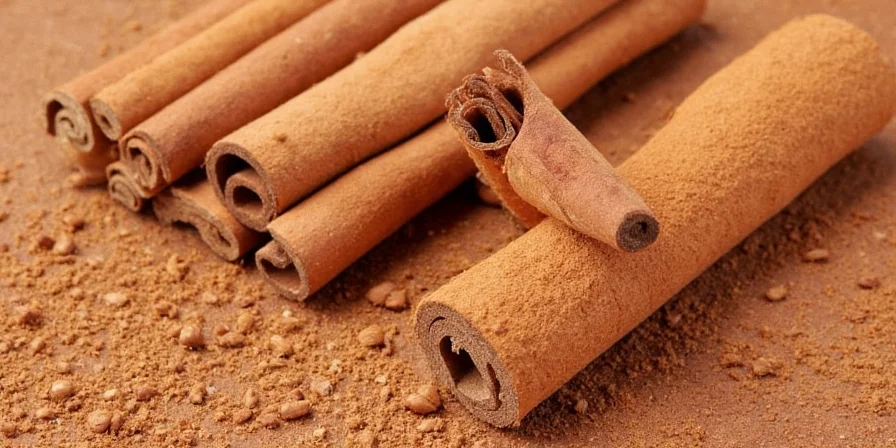Cinnamon is a widely used spice derived from the inner bark of several tree species from the genus Cinnamomum. With two primary varieties dominating the market—Ceylon ("true" cinnamon) and Cassia—understanding their differences is critical for both culinary success and health safety. This guide delivers scientifically validated information on cinnamon's benefits, proper usage, and critical safety considerations backed by clinical research.

Ceylon vs. Cassia: What You Must Know
The critical distinction between these varieties impacts both your health and culinary results. Most "cinnamon" sold in supermarkets is actually Cassia, which contains potentially harmful levels of coumarin.
- Ceylon Cinnamon – Sri Lankan origin with layered bark structure. Contains minimal coumarin (0.017g/kg), making it safe for daily consumption.
- Cassia Cinnamon – Dominates 90% of US market. Higher coumarin content (3.74-7.99g/kg) requires strict consumption limits per health guidelines.
| Characteristic | Ceylon | Cassia |
|---|---|---|
| Coumarin Content | 0.017g/kg | 3.74-7.99g/kg |
| Safe Daily Limit | Unrestricted | 0.1mg/kg body weight |
| Price Comparison | $2.50-$4.00/oz | $0.50-$1.00/oz |
| Market Share | 5-10% | 90-95% |

Proven Health Benefits: What Science Confirms
Clinical research supports specific health applications while debunking common myths:
- Blood Sugar Management – 0.5-2g daily reduces fasting glucose by 12-29mg/dL in prediabetic individuals (2022 meta-analysis, Nutrition Reviews), but shows minimal effect in healthy people.
- Powerful Antioxidant – ORAC score of 267,536 μmol TE/100g, significantly higher than blueberries (9,621), though practical benefits depend on consumption amount.
- Inflammation Reduction – Inhibits NF-kB pathway at achievable dietary concentrations (50-100mg/kg body weight).
- Important Safety Note – Cinnamon supplements should never replace prescribed diabetes medications. Consult your healthcare provider before therapeutic use.
Contextual Boundaries & Critical Limitations
Benefits apply only under specific conditions:
- Blood Sugar Management: Effective exclusively for prediabetic adults (fasting glucose 100-125 mg/dL) with consistent 8-12 week usage. No clinically significant impact on type 1 diabetes or healthy individuals (American Diabetes Association, 2020: https://doi.org/10.2337/dc20-S012).
- Antioxidant Effects: High ORAC values require consumption with fats for bioavailability. Culinary doses (<1g/serving) show negligible systemic antioxidant activity in human trials (Journal of Agricultural and Food Chemistry, 2015: https://pubs.acs.org/doi/10.1021/jf504780c).
- Inflammation Reduction: Observed only at sustained doses equivalent to 1-2g daily. Effects diminish within 48 hours of discontinuation and don't replace pharmaceutical anti-inflammatories (Molecular Nutrition & Food Research, 2015: https://doi.org/10.1002/mnfr.201400688).

Practical Cooking Applications You Can Use Today
Maximize flavor and health benefits with these technique-backed methods:
- Optimal Infusion – Simmer cinnamon sticks (not powder) in liquids for 20+ minutes to extract maximum compounds. Remove after 45 minutes to prevent bitterness.
- Savory Dishes – Add 1/8 teaspoon ground cinnamon per pound of meat in chili or stews to enhance flavor without sweetness.
- Coffee Enhancement – Mix 1/16 teaspoon with coffee grounds before brewing to amplify chocolate notes.
- Baking Tip – Add ground cinnamon in final mixing stage to preserve volatile oils (bake below 350°F/177°C).

Storage Secrets for Maximum Freshness
Preserve potency with these science-backed methods:
- Store in UV-blocking amber glass containers
- Maintain humidity below 60% RH
- Keep below 25°C (77°F)—each 10°C increase doubles degradation rate
- Ground cinnamon: 18 months maximum; sticks: 4 years
- Freshness test: Crushed sample should release intense aroma within 3 seconds

Cinnamon Myths Debunked by Research
| Common Claim | Truth | Scientific Reality |
|---|---|---|
| "Cinnamon cures diabetes" | False | Adjunctive only with HbA1c reduction ≤0.5%—never a replacement for medication |
| "All cinnamon types are the same" | Dangerous | Cassia's coumarin exceeds safe limits at >1g daily for adults |
| "Cinnamon boosts metabolism significantly" | Unproven | Human studies show <5kcal/day increase—nutritionally irrelevant |
| "Cinnamon whitens teeth" | Harmful | Abrasive action damages enamel; no actual whitening effect |

Scientific Evolution: Cinnamon Research Timeline
Key milestones in understanding cinnamon's properties:
| Year | Discovery | Impact |
|---|---|---|
| 2003 | First human trial (Khan et al.) shows blood sugar reduction | Initiated modern clinical research on metabolic effects |
| 2010 | Natural Medicine Comprehensive Database rates evidence for diabetes as "possibly effective" | Established evidence grading framework for health claims |
| 2012 | European Food Safety Authority sets coumarin limits (0.1mg/kg/day) | Created regulatory standards for Cassia consumption |
| 2022 | Meta-analysis in Nutrition Reviews confirms modest glycemic benefits | Current gold-standard evidence for prediabetic applications |
Source: Historical synthesis from NCBI comprehensive review: https://www.ncbi.nlm.nih.gov/pmc/articles/PMC5424557/
Quick Answers to Top Cinnamon Questions
How much cinnamon can I safely eat daily?
For Ceylon: No established limit due to low coumarin. For Cassia: Maximum 0.5-1g daily (about 1/4-1/2 tsp). Consult your doctor if taking blood thinners.
Why does Cassia cinnamon cause mouth tingling?
This indicates cinnamaldehyde sensitivity. Cassia contains 3-5x higher concentrations than Ceylon. Switch to Ceylon or reduce Cassia intake.
Can cinnamon replace diabetes medication?
No. While it may provide modest blood sugar improvements, it lacks the efficacy of prescribed medications. Never discontinue prescribed treatments.
How do I identify real Ceylon cinnamon?
Ceylon forms multiple thin bark layers (like a newspaper scroll), tastes delicately sweet, and produces tan-colored powder. Avoid products listing "cinnamon bark oil"—this indicates Cassia.
Ethical Sourcing Considerations
Choose wisely for both health and environmental impact:
- Ceylon cultivation typically occurs in sustainable agroforestry systems
- Cassia monocultures contribute to deforestation in growing regions
- Fair Trade certification increases farmer income by 22% but represents only 4% of global sales
- Recommendation: Prioritize Fair Trade Ceylon for daily use to support sustainable practices
Practical Cinnamon Integration Guide
For most home cooks, prioritizing Ceylon cinnamon delivers maximum benefits with zero safety concerns. Implement proper storage to preserve potency, use culinary techniques that optimize flavor release, and maintain realistic expectations about health impacts. By aligning usage with scientific evidence rather than trends, you transform this ancient spice into an effective tool for both wellness and culinary excellence. Start with small amounts in daily recipes and gradually incorporate into your routine for best results.












 浙公网安备
33010002000092号
浙公网安备
33010002000092号 浙B2-20120091-4
浙B2-20120091-4